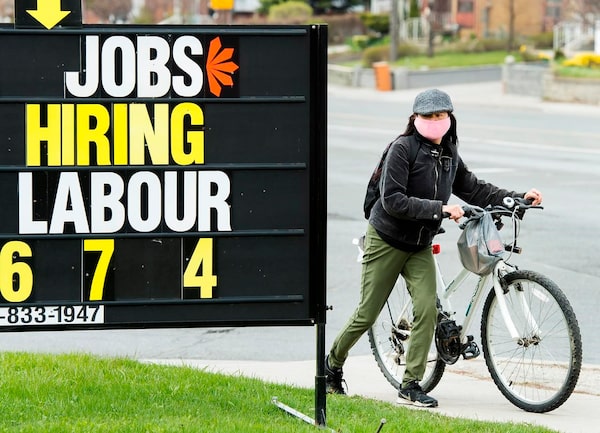
A woman passes a sign advertising jobs in Toronto on April 29, 2020. The labour market has now recovered about 55 per cent of the three million jobs lost between February and April.The Canadian Press
The Canadian economy added 418,500 jobs in July as pandemic restrictions eased across the country, marking the third consecutive month of rising employment after millions of jobs were lost earlier this year.
The results were more subdued than June’s gain of 952,900, but were accompanied by a sharp reduction in the unemployment rate, to 10.9 per cent from 12.3 per cent, Statistics Canada reported Friday.
The labour market has now recovered about 55 per cent of the three million jobs lost between February and April, when COVID-19 forced lockdowns that shuttered non-essential businesses.
“Long story short, this is great so far,” said Brian DePratto, senior economist at Toronto-Dominion Bank. “But I do think that, particularly as we get into the fall, it could be a much more gradual, drawn-out recovery that emerges.”
The coming months include no shortage of challenges that could weigh on hiring: a slower pace of reopening, a shortage of daycare spaces and the expiration of government income supports that have bolstered household spending.
At the same time, there is plenty of ground to recover, with employment down roughly 1.34 million from February and almost a million people working less than half their usual hours for pandemic-related reasons.
Still, the Canadian jobs recovery has outpaced that of the United States, which on Friday reported a gain of 1.8 million positions last month. To date, the U.S. has recouped about 42 per cent of its pandemic job losses and has struggled with a recent surge of COVID-19 cases and persistently high numbers of people filing unemployment claims.
Canada has done a “better job in terms of keeping that curve flat to downward on new infections,” Mr. DePratto said. “So we’ve seen slightly better momentum [in Canada] coming out the other side.”
Friday’s Statscan report showed most of July’s job growth was in part-time work (345,300), which suffered significantly worse losses than full-time labour in March and April, owing to its prevalence in hard-hit industries such as retail, tourism and hospitality.
The services sector saw employment jump by 347,900, while the goods sector expanded by 70,600. Total employment in both sectors now stands at roughly 93 per cent of prepandemic levels. In particular, the food services and retail industries posted a combined rebound of some 192,000 positions in July.
Ontario led the provinces with 150,700 jobs added last month. Friday’s report, which pertained to labour conditions between July 12 and 18, was the first to reflect a partial reopening of services in Toronto, where employment in the broader area increased by 68,400 in July.
Friday’s report was also notably the first to ask respondents if they identified as racialized. The results pointed to a disproportionate impact on several groups.
The jobless rate for the entire population between the ages of 15 and 69 was 11.3 per cent in July, unadjusted for seasonality. For those who did not identify as racialized or Indigenous, the jobless rate was 9.3 per cent. However, the rate was substantially higher for South Asian (17.8 per cent), Arab (17.3 per cent) and Black (16.8 per cent) Canadians. Using an experimental method to gauge past employment, Statscan estimated that South Asian and Chinese-Canadians have experienced the largest jobless rate increases over the past year.
Statscan said higher joblessness among racialized people may be partly attributable to their higher representation in struggling industries such as accommodation and food services.
“Who’s hurting the most in Canada is South Asian and Chinese populations,” said Armine Yalnizyan, an economist and Atkinson fellow on the future of workers. “They got the hardest hit” by pandemic job losses.
As the recovery progresses, one immediate concern is the safe reopening of schools and daycare facilities. Children’s health advocates have panned some provincial plans and warned that full availability of daycare spots is unlikely come September.
A potential outcome is that parents – women, especially – will sacrifice work to look after children, Ms. Yalnizyan said. “If women don’t work, households have less income. If households have less income, they spend less. So your No. 1 driver for [gross domestic product], your No. 1 channel for recovery, is at risk.”
In the coming weeks, the Canada Emergency Response Benefit – which pays $2,000 every four weeks to workers affected by the pandemic – will be phased out. Some workers will be moved over to employment insurance; the federal government intends to relax the qualification criteria in order to include more people.
Those who don’t qualify for EI, such as gig workers, will be covered by a “parallel benefit” that Prime Minister Justin Trudeau said would allow people to “work more hours and earn more money while receiving the benefit.”
Ottawa appears to be targeting a policy solution that would incentivize the return to work without axing the financial supports that many underemployed people still need.
“The reason we want to move away from CERB is to create the message and the expectation that we’re moving into a different phase,” Minister of Employment Carla Qualtrough said in a recent news conference.
“We’re no longer in the emergency phase. ... We want to create supports that contribute to people returning to work.”
Your time is valuable. Have the Top Business Headlines newsletter conveniently delivered to your inbox in the morning or evening. Sign up today.